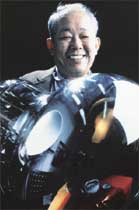Congratulations to Prof. Koshiba

Announcement of the Nobel prize award for Professor Koshiba on the 8th of October was a delight for me and am very proud of being one who studied under him. After the discovery of neutrinos from the supernova in 1987, we have been hoping for this to happen. It’s been a long time since then. Unfortunately, I was in CERN so that I could not visit and directly congratulate him on the day. Nobel Foundation states the reason clearly that “With another gigantic detector, called Kamiokande, a group of researchers led by Masatoshi Koshiba was able to confirm Davis’ results. They were also able, on 23 February 1987, to detect neutrinos from a distant supernova explosion. They captured twelve of the total of 1016 neutrinos that passed through the detector. The work of Davis and Koshiba has led to unexpected discoveries and a new, intensive field of research, ”neutrino-astronomy”. (
http://www.nobel.se /physics /laureates /2002 /index.html ) I am very happy to be included in “a group of researchers” in the statement.
Professor Koshiba is a very well known person, but I would like to mention a few things about him. His motto “Do what others do not do” and its supplement “Construct devices others do not have” are quite important for experimentalists who have to make their own detectors. One should note that what people do not do is often due to its uselessness. Professor Koshiba is outstanding in that he discovers important and unnoticed research subjects by his instinct. I have been hoping to acquire such instinct myself. Professor Koshiba has many friends from very wide range of fields that are unrelated to garden variety physicists. He used to host a gathering called “Gathering of Quarks” at the beginning of each year. Among the participants of the gathering were prominent government officials and politicians, musicians, novelists, key persons in business world and in academic world whom one would only find in books. How he got acquainted with these people and how he became good friend with them is a mystery for me.
Professor Koshiba speaks up to anyone straight, including to his students. We would counterattack when we feel something is wrong in his statements. However, we often end up to find that there were far more story behind it and that often turned out to be something very important. So, we always listen carefully to what he says.
I am happy because the award is the recognition of his great achievement. Making use of his years of experience, his keen sense as a scientist, broad knowledge and insight, he comes up with interesting theme and creates detectors others never thought of. He is also excellent in getting people organized and push them for it, which is not something everyone can do.
When I learned about the Kamiokande project, some of us studying under him were in DESY. He proposed us to search for the proton decay after showing us the result of simulation. My first impression was it is too far beyond to make use of thousands of tons of water to detect Cherenkov light from the decay. By the time when I came back to Japan in 1981, R&D for the 50cm-diameter photomultiplier, R3600, was under way. It is a typical of his products as no one ever produced such thing before, and the tube was the key to the success for the result that followed, thanks to their outstanding efficiency to collect light. After number of improvements over the original phototube design, the phototubes are still used.
I would like to point out one more thing. Theorists predicted that the major decay mode of proton was “positron + neutral pi meson” which could be searched for with phototubes of 13 cm in diameter. However, that size phototube would not be useful to search for the decay mode “neutrino + charged K meson”. Professor Koshiba wanted to look at such difficult decay mode when others would not. His far sight, which otherwise would appear to be an over-done design, played the key role for the starting of neutrino-astrophysics. We, the experimental physicists, should keep this in mind.
The Kamiokande detector was succeeded by the Super-Kamiokande detector which discovered the atmospheric neutrino oscillation in 1998, which then get combined with the data from SNO experiment in 2001 proved the solar neutrino oscillation. We started to generate man-made neutrinos at KEK, that is 250 km away from the Super-Kamiokande, in 1999 to verify the experimental proof for the atmospheric neutrino oscillation. We are at 99% confidence level for the atmospheric neutrino oscillation. This experiment will be continued. In 2002, KamLAND experiment started which detects anti-neutrinos from nuclear power station to experimentally verify solar neutrino oscillation. We expect the first result from them in December this year.
As you can see, the students of Professor Koshiba are succeeding the neutrino research. I am sure that Professor Koshiba is happy about the success of his followers. However, we will have great competitors, as many prominent laboratories started research directly competing with us. Japanese would start good projects but often overtaken by western laboratories. We are pushing for the project at the high intensity proton accelerator complex (JHF) at Tokaimura to produce lots of neutrinos to be measured at the Super-Kamiokande 295 km away. In a future, we would be constructing “Hyper-Kamiokande” which would be 20 times larger than the Super-Kamiokande. We, having Professor Koshiba being the creator of the neutrino astrophysics, would like to stay in the leading role in this field. The finite mass of neutrino learned from the result of neutrino oscillation indicates that we are nearing the dream Professor Koshiba have, which is to see the proton decay. I would think that the Hyper-Kamiokande would finally see this. We hope his research activity with us will further continue.
